Sex, drugs and rock 'n' roll defined the 1960s. But the decade was also a time of pivotal change politically, socially and technologically. Check out 60 of the most iconic moments of the decade.
1. The 'Greensboro Four.' On February 1, 1960, four African-American college students made history just by sitting down at a whites-only lunch counter at a Woolworth's in Greensboro, North Carolina. Service never came for the "Greensboro Four," as they came to be known, and their peaceful demonstration drew national attention and sparked more "sit-ins" in Southern cities.
 |
| African Americans stage sit down at Woolworth Store's lunch counter, in which service was refused to them. (Photo by Donald Uhrbrock//Time Life Pictures/Getty Images) |
2. Elvis discharged from the military. Elvis Presley's musical heyday was in the 1950s, but he remained a major star in the 1960s. Here, Presley, 25, is pictured with his future wife, Priscilla, shortly before his discharge from the U.S. Army in 1960. Presley served two years in the Army.
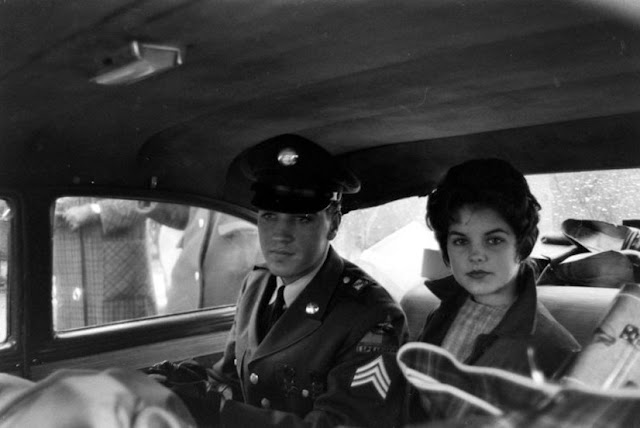 |
| Elvis and Priscilla leave the house he and his family occupied in Bad Nauheim, Germany, March 1960. |
3. Sharpeville massacre in South Africa. Wounded people in South Africa's Sharpeville township lie in the street on March 21, 1960, after police opened fire on black demonstrators marching against the country's segregation system known as apartheid. At least 180 black Africans, most of them women and children, were injured and 69 were killed in the Sharpeville massacre that signaled the start of armed resistance against apartheid.
 |
| Wounded people lie in the street, 21 March 1960 in Sharpeville, near Vereeniging, where at least 180 black Africans, most of them women and children, were injured and 69 killed, when South African police opened fire on black protestors. (Photo credit should read OFF/AFP/Getty Images) |
4. The laser is born. Theodore Maiman pours liquid nitrogen into a cooling unit around one of the first experimental lasers in his laboratory in Santa Monica, California. Maiman's ruby laser, created on May 16, 1960, is considered to be one of the top technological achievements of the 20th century. It paved the way for fiber-optic communications, CDs, DVDs and sight-restoring surgery.
 |
| Scientist and inventor of the laser Dr. Theodore Maiman pours liquid nitrogen into a cooling unit around one of the first experimental lasers in his laboratory in Santa Monica, Calif., on March 9, 1964. (AP Photo) |
5. FDA approves birth-control pill. On June 23, 1960, the U.S. Food and Drug Administration approved Enovid, the first birth-control pill for women.
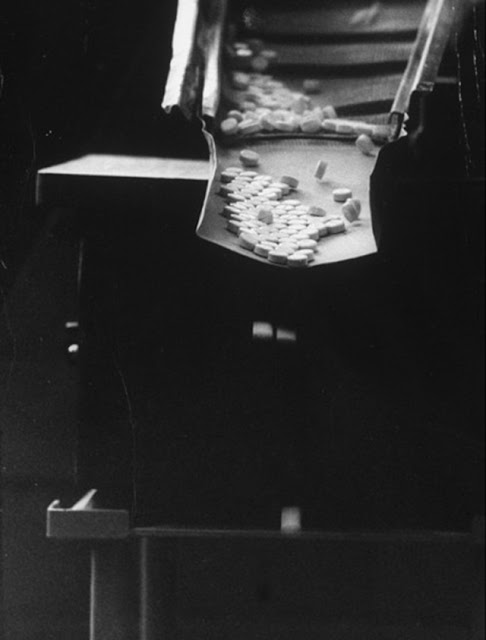 |
| Controversial `enovid bith control' pills recently investigated by the FDA. (Photo by Art Rickerby//Time Life Pictures/Getty Images) |
6. Nixon-Kennedy debate. The first televised presidential debate was on September 26, 1960, and it involved U.S. Vice President Richard Nixon, left, and Sen. John F. Kennedy of Massachusetts. The debate is largely credited with helping to make a star out of Kennedy, who won the election later that year.
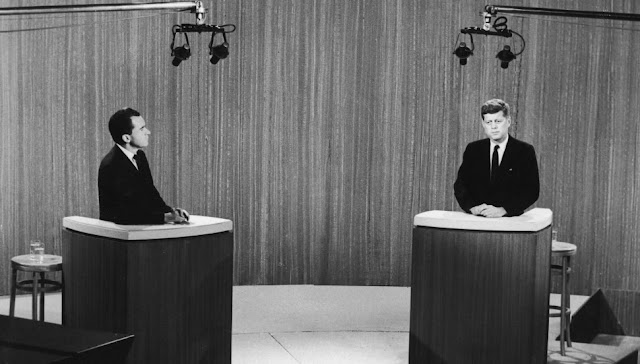 |
| Republican vice president Richard Nixon (L) and democratic senator John F. Kennedy take part in a televised debate during their presidential campaign. January 01, 1960. (Hulton Archive) |
7. Bay of Pigs invasion. Cuban leader Fidel Castro, lower right, sits inside a tank near Playa Giron, Cuba, during the Bay of Pigs invasion on April 17, 1961. On that day, about 1,500 CIA-backed Cuban exiles landed at Cuba's Bay of Pigs in hopes of triggering an uprising against Castro. It was a complete disaster for President John F. Kennedy's fledgling administration.
 |
| Cuban leader Fidel Castro, lower right, sits inside a tank near Playa Giron, Cuba, during the Bay of Pigs invasion, in this April 17, 1961 photo provided by Granma, the Cuban government newspaper. (CP Photo/Granma/Raul Corrales) |
8. 'Sex and the Single Girl.' Helen Gurley Brown, editor of Cosmopolitan magazine, published her book "Sex and the Single Girl" in 1962. The book helped spark the sexual revolution and popularize the notion that the modern woman could "have it all," including a successful career and a fulfilling sex life.
 |
| Helen Gurley Brown was Cosmopolitan’s editor from 1965 until 1997. (Santi Visalli/Getty Images) |
9. First interactive video game. In 1962, Massachusetts Institute of Technology students Steve Russell, Martin "Shag" Graetz and Alan Kotok created "Spacewar!" which is widely considered the first interactive video game. Dueling players fired at each other's spaceships using early versions of joysticks. This photo shows the three "Spacewar!" inventors playing the game at Boston's Computer Museum in 1983.
 |
| Initially conceived by Steve Russell, Martin Graetz and Wayne Wiitanen in 1961, Spacewar! is considered one of the earliest video games for a digital computer. The first version was written by Steve Russell in 1961. Significant improvements to the game were made in the spring of 1962 by Peter Samson, Dan Edwards and Martin Graetz. The game was rapidly copied and became a staple demonstration program for showing the sophisticated graphical capabilities of the PDP-1 system. |
10. 'Turn on, tune in, drop out.' The drug LSD became popular in the 1960s, leading the U.S. Food and Drug Administration to designate it an experimental drug in 1962. Harvard psychologist Timothy Leary, pictured here, became an advocate for the drug, coining the phrase, "Turn on, tune in, drop out.
 |
| A poster featuring and scripted by American philosopher Dr Timothy Leary, advising people to, 'Turn On, Tune In and Drop Out'. (Photo by A Jones/Getty Images) |
11. First James Bond movie. Before Daniel Craig or Pierce Brosnan, there was Sean Connery, who starred in the first James Bond film, "Dr. No," in 1962. With the most recent Bond film released in 2012 ("Skyfall"), the James Bond series is the longest running film series of all time.
 |
| Sean Connery played James Bond in "Dr. No" (1962). |
12. Marilyn Monroe dies. Actress Marilyn Monroe was found dead in her apartment on August 5, 1962, at the age of 36. Officials ruled her death as probable suicide from sleeping pill overdose, but to this day there remain many conspiracy theories.
 |
| Marilyn Monroe |
13. Spider-Man arrives. The No. 15 issue of the "Amazing Fantasy" comic book series, published August 10, 1962, marked the first appearance of Spider-Man. The issue is one of the most valuable comics of all time.
 |
| The Amazing Spider-Man Omnibus, Vol. 1. |
14. Carson takes over 'The Tonight Show.' Johnny Carson, right, took over "The Tonight Show" on October 1, 1962, with co-host Ed McMahon. They retired from the late-night talk show 30 years later. This year, Saturday Night Live alum Jimmy Fallon became the show's new host after Jay Leno, who hosted the show for 22 years.
 |
| THE TONIGHT SHOW STARRING JOHNNY CARSON -- Pictured: (l-r) Ed McMahon, host Johnny Carson during the first show on October 1, 1962 (Photo by NBC/NBCU Photo Bank via Getty Images) |
15. Cuban missile crisis. U.S. President John F. Kennedy delivers a nationally televised address about the Cuban missile crisis on October 22, 1962. After learning that the Soviet Union had begun shipping missiles to Cuba, Kennedy announced a strategic blockade of Cuba and warned the Soviet Union that the U.S. would seize any more deliveries.
 |
| U.S. President John F. Kennedy speaks before reporters during a televised speech to the nation about the strategic blockade of Cuba, and his warning to the Soviet Union about missile sanctions, during the Cuban missile crisis, on October 24, 1962 in Washington, DC. |
16. Boeing 727 debuts. Crowds in Seattle gather for the first viewing of the Boeing 727 jet in December 1962. The aircraft's first flight would take place on February 9, 1963. The 727 is credited with opening the door to domestic travel for millions of everyday Americans.
 |
| 1st December 1962: Crowds gather for the first view of the new Boeing 727 jet airliner at Seattle, Washington. (Photo by Central Press/Getty Images) |
17. Polaroid adds color. Inventor Edwin Land, president and co-founder of the Polaroid Corporation, demonstrates his company's new instant-color film in 1963.
 |
| Polaroid President Edwin Land demonstrating 60 second Polaroid Film, 1963. (Fritz Goro / Time Inc.) |
18. 'The Feminine Mystique.' Betty Friedan energized the feminist movement in 1963 with her book "The Feminine Mystique." The book detailed the frustration of women who were expected to rely on their husbands and children for their happiness.
 |
| circa 1970: American feminist and author Betty Friedan, a founder member of NOW (National Organisation of Women) and the author of 'The Feminine Mystique'. (Photo by B. Friedan/MPI/Getty Images) |
19. Patsy Cline's death. Patsy Cline performs at Nashville's Grand Ole Opry in this undated photo. The country music star and three others were killed in a plane crash March 5, 1963, near Camden, Tennessee.
 |
| This is an undated photo of country western singer Patsy Cline at Nashville's Grand Old Opry. (AP Photo) |
20. The Beatles' first album. The Beatles released their first album, "Please Please Me," in the United Kingdom on March 22, 1963. Here, the band is honored on November 18, 1963, for the massive sales of albums "Please Please Me" and "With the Beatles."
 |
| Sir Joseph Lockwood, chairman of EMI, presents The Beatles with two silver discs, to mark the 1/4 million plus sales of their two long playing records , 'Please, Please Me' and 'With The Beatles'. November 18, 1963. (Keystone) |
21. Alabama governor resists desegregation. Federal Deputy Attorney General Nicholas Katzenbach, standing on the right, confronts Alabama Gov. George Wallace at the University of Alabama in Tuscaloosa on June 11, 1963. Wallace is standing in the doorway to prevent two African-American students from entering despite a presidential order. Wallace, who was pro-segregation, later stood aside.
 |
| June 11, 1963, Tuscaloosa, AL: George Wallace, the Democratic Governor of Alabama, standing in the doorway of the administrative building of the University of Alabama in Tuscaloosa in order to prevent two African-American students from entering. Federal Deputy Attorney General Nicholas Katzenbach is seen standing right. Wallace had run for Governor with the slogan 'Segregation Forever'. (Photo by MPI/Getty Images) |
22. Medgar Evers assassinated. Myrlie Evers, widow of civil rights activist Medgar Evers, comforts their son Darrell while their daughter, Reena, wipes her tears during Evers' funeral on June 18, 1963. Evers was assassinated days earlier at his home in Jackson, Mississippi.
 |
| At the funeral for slain Civil Rights leader Medgar Evers, his wife, Myrlie Evers (second right), comforts their son, Darryl Kenyatta Evers, while daughter Reena Denise Evers (center, in white dress) wipes her own tears, Jackson, Mississippi, June 18, 1963. (Credit: Express Newspapers) |
23. JFK's Berlin speech. U.S. President John F. Kennedy delivers his famous "Ich bin ein Berliner" ("I am a Berliner") speech to a massive crowd in West Berlin on June 26, 1963.
 |
| 1963, Berlin, Germany - President John F. Kennedy exchanges greetings with the crowd at West Berlin City Hall. An estimated 250,000 persons crammed the large square to hear the President speak. Kennedy flew here for an 8-hour visit before the Ireland lef of his four-nation 10-day European tour. |
24. 'I Have a Dream.' The Rev. Martin Luther King Jr. gives his "I Have a Dream" speech to a crowd in Washington during the March on Washington for Jobs and Freedom, also known as the Freedom March, on August 28, 1963. The speech is considered one of the most important in American history, and it helped rally support for the Civil Rights Act of 1964.
 |
| Martin Luther King waves to supporters from the steps of the Lincoln Memorial. August 28, 1963. (AP/Getty Images) |
25. Cronkite becomes anchor. Walter Cronkite sits behind the news desk on the set of the "CBS Evening News with Walter Cronkite" in August 1963. One month later, it became network television's first nightly half-hour news program.
 |
| Walter Cronkite sits and smokes a pipe at the CBS news desk with Don Hewitt in the background. |
26. Birmingham church bombing. A coffin is loaded into a hearse at a funeral in Birmingham, Alabama, for victims of the 16th Street Baptist Church bombing. Four African-American girls were killed and at least 14 others were wounded when a bomb blast tore through church services on September 15, 1963. Three former Ku Klux Klan members were later convicted of murder for the bombing.
 |
| Coffin being loaded into hearse among crowd at funeral for victims of 16th Street Baptist Church bombing. (Photo by Burton Mcneely//Time Life Pictures/Getty Images) |
27. First push-button phone. The first push-button telephone was made available to AT&T customers on November 18, 1963. The phone had extension buttons at the bottom for office use.
 |
| The first push-button telephone is introduced on Feb. 28, 1963. This phone has extension buttons at bottom for office use. (AP Photo) |
28. President Kennedy assassinated. U.S. President John F. Kennedy was assassinated during a motorcade in Dallas on November 22, 1963.
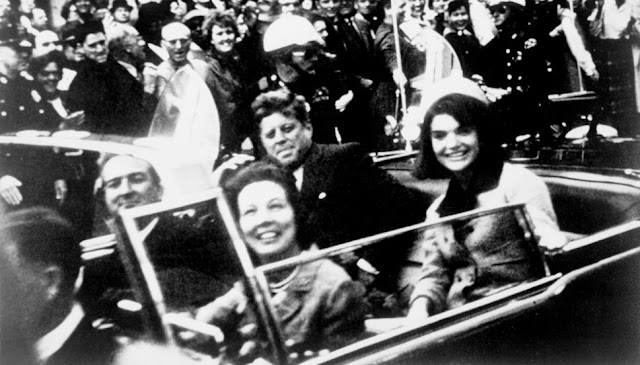 |
| John F Kennedy motorcade, Dallas, Texas USA, 22 November 1963. Close-up view of President and Mrs Kennedy and Texas Governor John Connally and his wife. (Photographer: Victor Hugo King. Credit: UniversalImagesGroup) |
29. Instant replay debuts. CBS used instant replay for the first time during the airing of the Army-Navy game that took place December 7, 1963, in Philadelphia's Municipal Stadium.
 |
| In this Dec. 7, 1963 file photo, Army's Ken Waldrop (42) plunges over the Navy defensive line to the two-yard line with 18 seconds remaining in the game in Philadephia. The fourth-downplay never came off as time ran out. Navy won 21-15. It's been 45 years since CBS used instant replay for the first time in the Army-Navy game from Municipal Stadium in Philadelphia. TV director Tony Verna, who called the first replay, takes a look back in his book "Instant Replay: The Day That Changed Sports Forever." (AP Photo/File) |
30. Berlin Wall opens. More than two years after it was constructed, the Berlin Wall opened for the first time on December 20, 1963, allowing citizens of West Berlin to visit their relatives in communist East Berlin.

31. Warhol and pop art. Artist Andy Warhol stands in the doorway of his studio, the Factory, in 1964, holding the acetate he used to make his famous Marilyn Monroe paintings. Warhol's work centered on famous personalities and iconic American objects, making him a leading figure in the pop art movement.
 |
| Warhol holding Marilyn Acetate I, 1964. |
32. 'Beatlemania' comes to the U.S. On February 9, 1964, the Beatles made their U.S. debut on "The Ed Sullivan Show," kicking off the American strain of "Beatlemania" — a fever that had already infected their native Britain.
 |
| Ed Sullivan smiles while standing with The Beatles on the set of his variety show on Feb. 9, 1964. (Express Newspapers/Getty Images) |
33. Ali becomes heavyweight champ. Boxer Muhammad Ali — then known as Cassius Clay — upsets Sonny Liston in a heavyweight title fight in Miami Beach, Florida, on February 25, 1964. He was 22 years old. A short time later, Clay joined the Nation of Islam and changed his name to Muhammad Ali.
 |
| FEBRUARY 25, 1964: Cassius Clay (now Muhammad Ali) in action against Sonny Liston during their heavyweight title fight at Miami Beach, Florida. Clay won the contest, becoming world champion, when Liston failed to come out at the start of the seventh round. (Photo by Central Press/Getty Images) |
34. Ford Mustang debuts. The 1965 Ford Mustang was first officially revealed to the public at the 1964 World's Fair in New York. Standard equipment included carpet, bucket seats and a 170-cubic-inch, six-cylinder engine that was coupled with a three-speed floor-shift transmission. With a price that started at just under $2,400, the car captured America's affection and is still being produced today.
 |
| Introducing the new 1965 Ford Mustang to the media in the Ford Pavilion at the 1964 World's Fair in New York. |
35. Mandela sentenced to life in prison. South African resistance leader Nelson Mandela, left, talks to Cape Town teacher C Andrews in 1964. On June 12, 1964, Mandela was sentenced to life in prison for four counts of sabotage. He was released 27 years later, and when apartheid ended he became the country's first black president.
 |
| circa 1964: Nelson Mandela, President of the African National Congress (left) in discussion with C Andrews, a Cape Town teacher. (Photo by Three Lions/Getty Images) |
36. Civil Rights Act of 1964. After signing the Civil Rights Act of 1964, U.S. President Lyndon B. Johnson shakes hands with the Rev. Martin Luther King Jr. The legislation outlawed discrimination in public places and banned discrimination based on race, gender, religion or national origin. It also encouraged the desegregation of public schools.
 |
| US President Lyndon Johnson (l) shakes hands with the US clergyman and civil rights leader Martin Luther KIng (c) 03 July 1964 in Washington DC, after handing him a pen during the ceremonies for the signing of the civil rights bill at the White House. (Photo credit should read AFP/AFP/Getty Images) |
37. 'Daisy Girl' ad. "Peace, Little Girl," a 1964 political ad for U.S. President Lyndon B. Johnson, was arguably the most famous — and the most negative — campaign ad in U.S. history. The ad, which played only once, showed a little girl counting daisy petals before an image of a nuclear explosion. Known as the "Daisy Girl" ad, it was credited with helping Johnson defeat U.S. Sen. Barry Goldwater in the landslide 1964 election.
 |
| "Daisy" advertisement. |
38. U.S. troops in South Vietnam. On February 9, 1965, the United States deployed its first combat troops to South Vietnam, significantly escalating its role in the war. Here, the U.S. Marines' 163rd Helicopter Squadron discharges South Vietnamese troops for an assault against the Viet Cong hidden along the tree line in the background.
 |
| VIETNAM - CIRCA 1965: US Marines 163rd helicopter Squadron discharging South Vietnamese troops for an assault against the Viet Cong hidden along the tree line in background. (Photo by Larry Burrows/Time & Life Pictures/Getty Images) |
39. Malcolm X assassinated. Civil rights activist Malcolm X is carried from the Audubon Ballroom in New York, where he had just been shot on February 21, 1965. He died shortly after.
 |
| Black activist Malcolm X is carried from the Audubon Ballroom where he had just been shot. He died shortly after, New York, New York, February 21, 1965. (Photo by Underwood Archives/Getty Images) |
40. 'Bloody Sunday.' State troopers swing batons to break up a civil rights voting march in Selma, Alabama, on March 7, 1965. "Bloody Sunday," as it became known, helped fuel the drive for passage of the Voting Rights Act of 1965.
 |
| Alabama state troopers break up the March 7, 1965 march in Selma with billy clubs. John Lewis, chairman of the Student Nonviolent Coordinating Committee, whose skull was fractured, is in the foreground. (AP Photo/File) |
41. Voting Rights Act. U.S. President Lyndon B. Johnson hands a pen to the Rev. Martin Luther King Jr. during the signing of the Voting Rights Act on August 6, 1965. The landmark legislation helped protect minorities who had previously encountered unfair barriers to voting.
 |
| President Lyndon B. Johnson gives Dr. Martin Luther King one of the pens used in the signing of the Voting Rights Act of 1965, in the background are Rep. Claude Pepper (center) and Rev. Ralph Abernathy, 1965. |
42. The Watts Riots. Two youths, carrying lampshades from a looted store, run down a street in the Watts neighborhood of Los Angeles on August 13, 1965. The Watts Riots were sparked by tensions between the city's black residents and police. The six days of violence left 34 dead and resulted in $40 million of property damage.
 |
| Two youths, with lampshades from a looted store, run down a street, in the Watts section of Los Angeles August, 13, 1965. The six days of violence left 34 dead and resulted in $40 million of property damage. (AP Photo) |
43. 'Batman.' The "Batman" TV series debuted in 1966, starring Adam West as the Caped Crusader and Burt Ward as his sidekick, Robin. The show aired for only three seasons, but it was a pop culture sensation at the time and a cult classic for future generations. There was also a feature film in 1966.
 |
| Adam West and Burt Ward. |
44. China's Cultural Revolution. Chinese leader Mao Zedong, standing front and center, rides through a Tiananmen Square rally in Beijing in 1966. In May of that year, Mao launched the Cultural Revolution to enforce communism and get rid of old institutions and his political enemies. The political movement careened out of control and led to massive political purges, deaths and destruction before it ended in 1976.
 |
| Chinese leader Mao Tse-tung (1893 - 1976), accompanied by his second-in-command Lin Biao (1907 - 1971), passes along the ranks of revolutionaries during a rally in Tiananmen Square, Peking (Beijing), 1966. (Photo by Keystone/Getty Images) |
45. First Super Bowl. The Green Bay Packers and the Kansas City Chiefs played the first Super Bowl on January 15, 1967, in Los Angeles. The Packers won the football game 35-10.
 |
| Green Bay Packers Hall of Fame quarterback Bart Starr (15) hands off to running back Elijah Pitts (22) during Super Bowl I, a 35-10 victory over the Kansas City Chiefs on January 15, 1967, at the Los Angeles Memorial Coliseum in Los Angeles, California. (Photo by James Flores/Getty Images) |
46. Six-Day War. Israeli soldiers stand in front of the Western Wall on June 9, 1967, in the old city of Jerusalem following its recapture from Jordanian rule in the Six-Day War.
 |
| 9th June 1967: Several Israeli soldiers standing close together in front of the Western, or Wailing, Wall in the old city of Jerusalem, following its recapture from Jordanian rule in the Arab/Israeli Six-Day War, Israel. (Photo by David Rubinger/Hulton Archive/Getty Images) |
47. Marshall on Supreme Court. Supreme Court Justice Thurgood Marshall, with his family at his side, takes his seat at the court for the first time on October 2, 1967. Marshall was the first African-American to be appointed to the high court.
 |
| Supreme Court Justice Thurgood Marshall's family is at hand to watch him take his seat at the court for the first time, Oct. 2, 1967. From left to right: sons Thurgood, Jr., 11, John, 9, wife Cecilia Suyat, and the Justice. (AP Photo/Henry Griffin) |
48. Anti-Vietnam protests. A demonstrator offers a flower to military police at the Pentagon during an anti-Vietnam protest in Washington on October 21, 1967. Marches such as this one helped turn public opinion against the war.
 |
| A demonstrator offers a flower to military police on guard at the Pentagon during an anti-Vietnam protest. |
49. First human heart transplant. Dr. Christiaan Barnard is shown after performing the first human heart transplant on patient Louis Washkansky on December 3, 1967, in Cape Town, South Africa.
 |
| Heart transplant surgeon Dr. Christiaan Barnard is shown after performing the first heart transplant on patient Louis Washkansky on December 3, 1967 in Cape Town, South Africa. Barnard headed a medical team that removed the heart of a 24-year-old woman who died in an auto accident and replaced the diseased heart of the dying 55-year-old businessman Washkansky. (AP Photo) |
50. Tet Offensive. South Vietnamese Gen. Nguyen Ngoc Loan, chief of the national police, executes suspected Viet Cong officer Nguyen Van Lem — also known as Bay Lop — on a Saigon street on February 1, 1968. It was early in the Tet Offensive, one of the largest military campaigns of the Vietnam War.
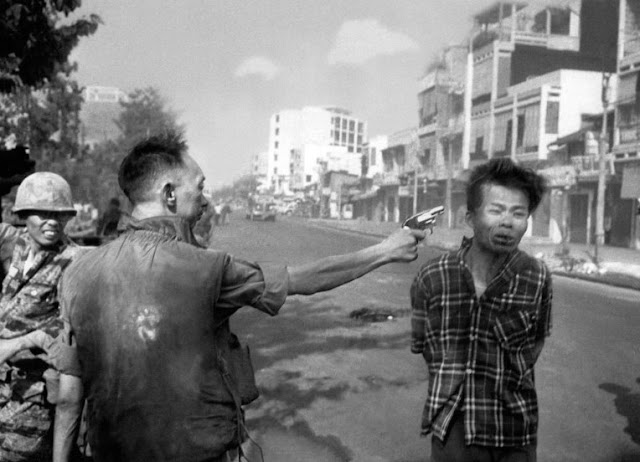 |
| South Vietnamese Gen. Nguyen Ngoc Loan, chief of the national police, fires his pistol, shoots, executes into the head of suspected Viet Cong officer Nguyen Van Lem (also known as Bay Lop) on a Saigon street Feb. 1, 1968, early in the Tet Offensive. (AP Photo/Eddie Adams) |
51. My Lai massacre. Houses in My Lai, South Vietnam, burn during the My Lai massacre on March 16, 1968. American troops came to the remote hamlet and killed hundreds of unarmed civilians. The incident, one of the darkest moments of the Vietnam War, further increased opposition to U.S. involvement in the war.
 |
| Houses burned by American soldiers during the My Lai massacre on March 16, 1968 in My Lai, South Vietnam. (Photo by Ronald S. Haeberle//Time Life Pictures/Getty Images) |
52. Martin Luther King assassinated. This photo was taken on April 4, 1968, moments after the Rev. Martin Luther King Jr. was shot and killed by a sniper as he stood on a balcony of the Lorraine Motel in Memphis, Tennessee. King was in Memphis to support striking sanitation workers.
 |
| Civil rights leader Andrew Young, left, and others on the balcony of the Lorraine Motel point in the direction where gunshots came from after the assassination of civil rights leader Martin Luther King Jr. on April 4, 1968. His body lays at their feet. (Joseph Louw/Time & Life Pictures/Getty Images) |
53. Robert F. Kennedy assassinated. U.S. Sen. Robert F. Kennedy, the brother of former President John F. Kennedy, was shot shortly after midnight on June 5, 1968, in Los Angeles. Sirhan Sirhan was convicted of assassinating Kennedy and wounding five other people inside the kitchen service pantry of the former Ambassador Hotel.
 |
| Politics, Crime, USA, Los Angeles, California, pic: 5th June 1968, Democratic Senator Robert Kennedy lies sprawled on the floor at the Ambassador Hotel after being shot, He died the following day from his injuries, with a Jordanian-American Sirhan B, Sirhan was convicted of the killing. (Photo by Popperfoto/Getty Images) |
54. Democratic National Convention unrest. Members of the New York delegation protest against the Vietnam War during the 1968 Democratic National Convention held in Chicago. Outside, riots erupted, with tens of thousands of Vietnam War protesters clashing with Chicago police and National Guard forces.
 |
| Vietnam War protests, 1968. |
55. Prague Spring. Residents of Prague, Czechoslovakia, throw burning torches in an attempt to stop a Soviet tank on August 21, 1968. A Soviet-led invasion by Warsaw Pact troops crushed the so-called Prague Spring reform and re-established totalitarian rule.
 |
| Prague residents carrying a Czechoslovak flag and throwing burning torches attempt to stop a Soviet tank in Prague, 21 August 1968 as the Soviet-led invasion by the Warsaw Pact armies crushed the so called Prague Spring reform in former Czechoslovakia. (Photo credit should read LIBOR HAJSKY/AFP/Getty Images) |
56. '60 Minutes' premieres. The iconic Sunday night news magazine "60 Minutes" premiered September 24, 1968, with Harry Reasoner, left, and Mike Wallace, right. At the center is Don Hewitt, the show's creator and producer.
 |
| September 1968 with Harry Reasoner, left, and Mike Wallace, right. Don Hewitt, the show's creator and producer, confers with the two correspondents. ?CBS Broadcasting Inc. All Rights Reserved. Credit: CBS Photo Archive. |
57. First men on the moon. Apollo 11 astronaut Edwin E. "Buzz" Aldrin Jr. salutes the U.S. flag on the lunar surface on July 20, 1969. Aldrin and mission commander Neil Armstrong became the first humans to walk on the moon. Their mission was considered an American victory in the Cold War and subsequent space race, meeting President Kennedy's goal of "landing a man on the moon and returning him safely" before the end of the decade.
 |
| Apollo 11 astronaut Edwin "Buzz" Aldrin Jr. salutes the U.S. flag on the surface of the moon on July 20, 1969. |
58. Woodstock Music Festival. Singer Roger Daltrey and guitarist Pete Townshend of The Who perform on stage at the Woodstock Music Festival in Bethel, New York. An estimated 400,000 people attended the festival, which took place in August 1969.
 |
| Singer Roger Daltrey and guitarist Pete Townshend of British rock band The Who on stage during a live concert performance at the Woodstock Festival in White Lake, New York, USA, 16 August 1969. (Photo by Archive Photos/Getty Images) |
59. Manson murders. Cult leader Charles Manson is taken into court to face murder charges on December 5, 1969, in Los Angeles. At Manson's command, a small group of his most ardent followers brutally murdered five people at the Los Angeles home of film director Roman Polanski on August 8-9, 1969, including Polanski's pregnant wife, actress Sharon Tate. Manson was convicted for orchestrating the murders and sentenced to death. The sentence was later commuted to life in prison.
 |
| Mass murderer Charles Mason being taken into court to face charges for a grand jury appearance in the murder of actress Sharon Tate and others by himself and members of his "Manson Family". (Photo By Vernon Merritt III/Time Life Pictures/Getty Images) |
60. Forebear of the Internet. With the help of a handful of leading universities and other labs, work began on a project to directly link a number of computers. In 1969, with money from the U.S. Defense Department, the first node of this network was installed on the campus of UCLA. The diagram shows the "network of networks" of ARPANET, as it was called. The forebear of the Internet was born.
 |
| Diagramme d'un reseau potentiel d'internet appele a l'epoque ARPANET (Advanced research projects Agency, US departement of defense) de Larry Roberts 1969, visible sans les divers etats Michigan Ilinois Utah, la faculte de USB (university of Santa Barbara). Le reseau ARPANET (predecesseur d'Internet qui se developpa a partir de 1969 avec la publication de la 1ere RFC inventee par Steve Crocker, 7 avril 1969) |